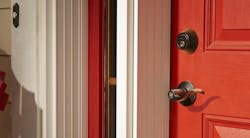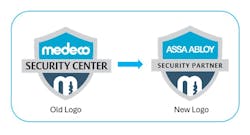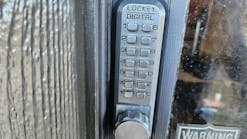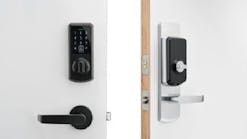Locksmiths have a choice as to the type and quality of locks they sell and install, and it’s for sure that not all locks are created equal. The issue of style is especially important to most if not all clients. The foremost reason for this is the fact that it’s the lockset on the door that serves as the first point of contact with members of the public. “Put your best foot forward” is probably the catch phrase of the day for this very reason. Companies such as Assa Abloy have gone to great lengths to make the various levers and other door hardware items interchangeable, not only between lock types, but even lock lines.
The make, model, and style of the lock(s) selected are often the result of on-site observation and eye-to-eye discussions held with the client. The objective is to derive a clear understanding to the risk(s) involved, what the client’s budget and expectations are, and what the environment is like before a final decision as to the right lock(s) for the job is made.
Where it comes to replacing an existing lock, however, it may not be necessary to conduct a full-scale investigation as cited above. Unless something in the situation has changed since the original locks were installed, all that may be necessary is to install the same make/model/style of locks that were there in the first place. Of course, in either case, the higher the quality of lock, the more secure and expensive it usually will be.
Grading Lock Strength
There’s a way to determine the relative strength of a door lock aide from years of experience. This is accomplished through a grading system that all lock manufacturers recognize. The following is a brief description of the various grades available.
- Grade 1 certification is commonly assigned to the “strongest grade ANSI recognizes for any residential or commercial product.” When a lock bears this certification, this is as good as it gets.
- Grade 2 certification: “Higher Residential Security Designed to offer excellent security and durability. Used mostly for residential applications and some light commercial applications.”
- Grade 3 certification: “Basic Residential Security The lowest grade provided by ANSI, and the minimal acceptable quality for residential door locks” (Source: http://bit.ly/1MJ996c).
The traditional lock choice -- where it comes to lock selection -- is that of a cylindrical or mortise lock. In this article we’ll examine the pros and cons of both types, we’ll talk about ease of installation, and the relative strength assigned to each one. We’ll also look at available trim and recent additions to stylish lock hardware.
Layered Protection
Let us begin by discussing locks and their role in the prevention of crime. The fact is, almost everything we do as a locksmith equates to “crime prevention.” Having a strong, quality lockset and deadbolt on each perimeter door actually acts to deter most criminals. The installation of quality locks is merely part of a larger philosophy where protection is administered in a layered manner.
Whether it involves residential, commercial, multiple-family, or institutional protection, this includes a regiment of physical precautions, such as quality locks in addition to adequate lighting, sensible landscaping, and a variety of electronic safeguards, such as outside motion lights, underground seismic detection, cameras with video motion detection, and others.
In terms of best practices, probably the first point of concern with regards to protecting single and multi-family homes, businesses, and institutions is the space between public accessible spaces, such as sidewalks, streets, yards, and parking lots, vacant ground—all of which adjoin the building(s) that you’re asked to protect. For example, the contour of the land, landscaping, should be conducive to creating a clear view of the protected facility from said public spaces to the client’s home or buildings. There also should be enough lighting to illuminate the grounds for better safety and security.
The next and probably the most important consideration is that of security at specific perimeter doors. Besides utilizing quality hardwood or metal doors, the locks used thereon are of immense importance to the overall security of the facility.
Cylindrical Pin Tumbler Locks
The pin tumbler, cylindrical lock had its beginning in Egypt more than 4,000 years ago. More recent designs began with a father-son team bearing the well known name of “Yale.”
“In 1848, Linus Yale, Sr. invented the modern pin-tumbler lock. In 1861, Linus Yale, Jr. was inspired by the original 1840s pin-tumbler lock designed by his father, thus inventing and patenting a smaller flat key with serrated edges as well as pins of varying lengths within the lock itself, the same design of the pin-tumbler lock in use today” (Wikipedia, http://bit.ly/1Ud141C).
In the early 1920’s, Walter Schlage improved on the basic design by adding two buttons between the two knobs.
The biggest advantage to installing a cylindrical lock is ease and speed associated with installation. Depending on the materials used in the construction of a door, installation requires the cutting of two round holes, the main one for the lock body, which are traditionally either 2-1/4 or 2-3/8 inch, with a smaller ¾-inch hole drilled perpendicular to the first, which is for the latch or bolt.
Where it comes to quality, which dictates the degree or level of security and ultimately price, pricing can vary from less than $4 to more than $100 0 per lock. It’s quality and style that determines price, but after years of working with cylindrical locks, professional locksmiths are sure to form an opinion regarding the relative strength of each make/model they use.
Putting Mortise Locks to Good Use
Another type of lock commonly used by professional locksmiths is the mortise lock.
“A mortise lock (mortice lock in British English) is a lock that requires a pocket—the mortise—to be cut into the door or piece of furniture into which the lock is to be fitted. In most parts of the world, mortise locks are found on older buildings constructed before the advent of bored cylindrical locks, but they have recently become more common in commercial and upmarket residential construction in the United States” (Source: http://bit.ly/1Rv6b9y).
Mortise locks come in two basic types, the warded mortice lock and the more modern Euro cylinder mortise lock. The warded mortice lock has been in existence far longer than the Euro type. Warded keys are actually lever-oriented ones, which means that they 1) are extremely vulnerable to those who understand how they operate, and 2) offer a limited number of available keys to choose from. Euro cylinder keys, however, offer a virtually unlimited number of key combinations.
Whether we’re talking about the warded or the Euro mortise lock, the mechanism is designed to fit into a small pocket cut out inside the door. Because of this, as well as the fact that the mechanism itself is noticeably stronger than the average cylindrical pin tumbler lock, the mortise lock will provide a higher degree of security.
Stylish Security
The Studio Collection from SARGENT features styled door trim that are available in a broad array of designs and finishes. This collection enables inspired design professionals to incorporate their aesthetic vision into any opening, allowing a consistent appearance regardless of the door's function. The Gramercy series, for example, was inspired by the architectural innovation of the New York City neighborhood of Gramercy Park, this collection of levers from SARGENT brings fashionable style and streamlined design to every opening.
New designs include the Grant Park series levers, influenced by Chicago’s architectural innovation such as the Smurfit-Stone Building, and the Wooster Square collection. One of New Haven’s most prominent neighborhoods, Wooster Square was the home to many SARGENT employees in the late 1800s. Reflective of the 19th century craftsmanship that these people brought to the area, The Wooster Square Series blends modernday materials with tasteful, clean lines
For more information on the Studio Collection, go to http://bit.ly/1odBXxi.
Master Lock® Residential Door Hardware offers the latest high-quality products that combine the power of reliable performance with popular new styles and finishes and great benefits. Clients have their choice of style including biscuit, ball or tulip knobs, and straight or wave levers. The full-size knobs are easy to operate; they provide superior value with a metal chassis and no plastic or die-cast parts. All knobs, levers and deadbolts are available in stylish polished brass, satin nickel, antique brass and aged bronze finishes.
Master Lock Residential Door Hardware offers a dependable replacement for any brand of door hardware. These products meet ANSI Grade 3 standards, and offer a corrosion-resistant solid brass cylinder plug. The line is available with KW1, SC1 and WR3/5 keyways. Stock the keyways as full locksets or order replacement cylinders to customize knobs, levers and deadbolts on-site. An all-steel universal latch adjusts to fit every door type. For more info, go to http://bit.ly/22OVoMH.
The 5255 Wave Lever by Baldwin Hardware offers keyed entry with Classic Rose included. Made of solid forged brass, this stylish lock features a latch bolt that also is constructed of solid brass. The latch is constructed for durability and smooth operation and includes a rose designed to conceal a 2.125-inch bore. The 5255 Wave Lever fits 1.375"-1.75" thick doors.
The LISCIO Electronic Keypad Leverset with Bluetooth Programming from Emtek offers the best in style and high-tech security in residential environments. This tubular pin-type lock uses a standard, common lock format with a 2⅜ or 2¾ inch backset. A series of buttons on the lever provides keyless entry along with a free smartphone app. An easy-to-use app wizard walks you through the steps for Bluetooth setup. Key access also offers access using the conventional approach. For more info, visit http://emtek.com/ElectronicLocks/liscio.
Also new from Emtek is the Modern Rectangular Pocket Door Mortise Lock, giving pocket doors a clean, contemporary trim style with a high-quality lock. This updated design has a d-ring thumbturn for easy operation and a through-bolt lock body for quick installation.
Types of Locks
(Covered in ANSI/BHMA Standards A156.2, A156.5, A156.12 and A156.13)
Auxiliary Lock. A lock having a latch bolt or a dead bolt operated by a key or a thumbturn or both. This lock is often used in addition to another lock, which may or may not be key operated but which has a latch bolt operated by knobs or levers.
Bored Dead Latch. (Also called tubular or cylindrical dead latch) A lock fitting round bored openings in the face and edge of a door and having a dead latch operated by a key or thumbturn or both.
Bored Dead Lack. (Also called cylindrical or tubular) These are locks or latches fitting round bored openings in the face and edge of a door. If they are key operated, the cylinder is contained in the knob and so occasionally one hears them referred to as "key-in-the-knob-locks." This is imprecise as other types of locks also have cylinders contained in the knobs. The round hole in the face of the door is usually 2 1/8 inches in diameter and the hole in the edge of the door is 7/8 inch to 1 inch. When the lock is installed, the face hole contains the lock body and the edge hole contains the latch bolt.
Double Cylinder Dead Bolt. Any type of auxiliary lock requiring a key to project or retract the dead bolt (lock or unlock) from either side.
Interconnected Lock. (Also known by a number of different trade names) A lock having a separate latch and dead bolt mechanically interconnected and installed in round bored openings in the face and edge of a door. It is best known for providing dead bolt security with the life safety feature of simultaneous retraction. When the dead bolt is projected, a single turn of the inside knob retracts both the dead bolt and the latch bolt. This simultaneous retraction function is also available with some functions of mortise locks.
Mortise Dead Latch. An auxiliary lock fitting a cavity prepared in the edge of the door and having a dead latch operated by a key or thumbturn both. The key or thumbturn engages the lock through holes prepared in the faces of the door.
Mortise Dead Lock. An auxiliary lock having a deadbolt instead of a dead latch and otherwise the same as a mortise dead latch.
Mortise Lock. A lock fitting a rectangular shaped cavity in the edge of a door. A round hole in the face of the door receives a spindle to which knobs or levers are attached. If key operated, a second round hole above the first receives the cylinder(s) and thumbturn. Some functions use two cylinders which is not a violation of the codes because the inside knob always operates. Some functions use two cylinders which sometimes is a violation of codes because the inside key projects a dead bolt or locks the inside knob which can only be unlocked by key. (This example of key operation on the inside applies equally to other types of locks and is mentioned under mortise locks only because it originated with them.)
Source: Builders Hardware Manufacturers Association (BHMA): http://www.buildershardware.com/resources/Terminology/types-locks






